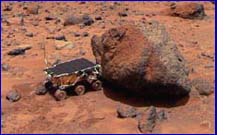
Yogi (with the Sojourner Rover taking its Alpha Proton X-ray Spectrometer measurement). The reason for Yogi's different colors is not known. It could be due to wind-blown dust, or it may be evidence that Yogi was part of a larger rock.July 23 1997. Courtesy of NASA.

 Cars on Mars!
Cars on Mars!
On July 4th, the spacecraft called Mars Pathfinder parachuted and bounced onto the Martian surface. Landing right side up, it pulled in the air bags that had helped it land, and put out a couple of ramps to the surface. Then a little robot vehicle called Rover Sojourner rolled onto the red, dusty soil.
So far as we know, Sojourner was the first wheeled vehicle to operate on another planet. And the 10-kilogram rover carried a ton of scientific hopes. During the couple of weeks that the six-wheeler has been scooting over the surface of Mars, its digital camera, computer, radio, and chemical detector have worked more or less as planned -- although a human goof-up on the ground has cost the mission at least one work day.
 Sojourner is no speedster -- it winds out at a full 60 centimeters per minute -- but it's smart enough to keep out of mischief. The little rover "operates on the surface without human intervention during the course of the day," says Steve Stolper, a flight software engineer for the Pathfinder project at the Jet Propulsion Laboratory (JPL) in Pasadena, Calif. "It can negotiate obstacles on its own, and can determine whether it needs human intervention if it can't figure its way out of a problem."
Sojourner is no speedster -- it winds out at a full 60 centimeters per minute -- but it's smart enough to keep out of mischief. The little rover "operates on the surface without human intervention during the course of the day," says Steve Stolper, a flight software engineer for the Pathfinder project at the Jet Propulsion Laboratory (JPL) in Pasadena, Calif. "It can negotiate obstacles on its own, and can determine whether it needs human intervention if it can't figure its way out of a problem."
That makes Sojourner an "autonomous vehicle" -- a robot that can find its way and make some decisions without human help. As we'll see later on, such vehicles will soon revolutionize not just space science, but also oceanography and other fields of research. And they might -- possibly -- even revolutionize your commute.
Up on Mars, Sojourner is not being given enough rope to hang itself. Each move is highly planned by the humanoids down at JPL, who want to accomplish some serious science before something goes irreversibly wrong.
Sojourner's main scientific payload is an alpha proton X-ray spectrometer. This gizmo nuzzles against a target rock and emits alpha particles -- energetic helium nuclei. Then it "reads" the X-rays generated from the rock. Since each element produces a "signature" X-ray, the spectrometer thus determines the composition of rocks.
In their first analyses, scientists have seen rocks that look like quartz, indicating that Mars has undergone much more geologic change than anticipated. They'd expected andesite -- a kind of lava found in the Andes Mountains in South America that was created over a simple geologic history.
They've also analyzed Barnacle Bill and found that it's chemical composition seems identical to the meteorite found in Antarctica which is thought to harbor signs of life.
Anyone remember the radar detector?
So how does little Sojourner get from point A to point B? The process starts with images of Sojourner's surroundings shot by a stereo camera on the lander. The images are shown on a computer monitor, where anyone wearing what Stolper calls "funky 3-D glasses" will see "an astounding 3-D effect." The controllers use those images to pick interesting targets and give them a scientific name like "Barnacle Bill" or "Scooby Doo."
Then the scientists establish some "waypoints" on the route to the target. Waypoints are the computerese equivalent of "Go to the statue of the pink flamingo and make a left, then go to the second traffic light and make another left."
After the lander receives the commands, it relays them to the rover, which can finally hit the highway, dodging traffic, obeying traffic lights, and generally tipping its hat to the Martian highway patrol.
With that tortoise-class pace, Sojourner needn't worry about speed limits. But it is not supposed to drive off a cliff, since tow trucks charge by the mile for the trip, and NASA Can't Afford That. That's where Sojourner's secret weapon, a nifto-dando laser beam, comes in. The laser "paves" a strip of light on the ground in front of the rover, and a second device reads the reflections.
While you and I could easily interpret a video picture of the Martian highway, the laser makes things simple enough for Sojourner's limited brainpower. "A continuous strip means a smooth surface," Stolper says. "If there are obstacles, you'll see discontinuities, and if there's a cliff, the line will disappear." When Sojourner detects a cliff, it stops and asks for advice, Stolper says. (The little rover also has a tilt gauge and touch sensors to detect obstacles.)
Why all the safety systems? For one thing, Earth's a long way away -- 22 minutes by round-trip radio signal. And a disaster -- getting flipped upside down like a hapless beetle -- could happen long before the rover could call for help. For another, Stolper says, "Computers are notoriously poor drivers."
(For an entertaining look at upcoming Mars rovers, see "Beach Buggies on Mars" in the bibliography.)
But Sojourner isn't the only autonomous vehicle on the surface of Mars.



